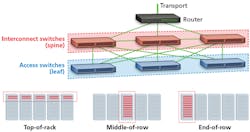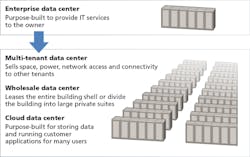Next-generation multimode fiber technology is on the way
An IEEE task force is developing a new 400-Gbit/sec Ethernet standard for multimode fiber, and the biggest impact is going to be felt in the data center.
By Andy Jimenez, Anixter
Skyrocketing network and server traffic, driven by the migration of enterprise workloads to the public and private cloud, has underlined the need for higher data rates and density of fiber optics in data center spaces that support cloud-based applications. While singlemode fiber can support 200- and 400-Gbit/sec data rates over distances up to 10 kilometers, it remains a high-cost option for the dense deployments required in hyperscale data centers.
The IEEE has formed a task force to develop the IEEE 802.3cm standard for 400 Gbits/sec over multimode fiber that will enable deployment of cost-optimized lower-fiber-count solutions over the installed base, as well as greenfield multimode fiber cabling, for 200 and 400 Gbits/sec by leveraging technologies currently under development.
The leaf-spine network architecture enables low-latency, high-data-rate switch-to-switch connections using multimode fiber. It is favored in many hyperscale data centers.
Transforming the hyperscale data center
Where the 802.3cm standard will make the biggest difference is in global webscale data centers and perhaps some of the largest enterprise data centers (see sidebar). Customer adoption of off-premise solutions has changed the way data center network infrastructure is architected. While data transmission speed still dominates, low latency has also proven to be critical to designing a data center for high performance, flexibility and scalability.
400-Gbit/sec backbone circuits in the data center facilitate the migration of 10- to 40-Gbit/sec connectivity to the server. More capacity is required to deliver network traffic from the distribution and access layers of the data center network to the core.
Leaf-spine network architecture
A primary use of multimode fiber is in the switch-to-switch connections of a leaf-spine network architecture, which is favored in many hyperscale data centers due to its very high-data-rate, low-latency connection between servers. In this two-layer architecture, the leaf switches located in top-of-rack, middle-of-row or end-of-row physical configurations can be connected to the spine switches using short-reach optical modules operating over multimode fiber.
The IEEE 802.3cm standard has technical objectives for 400-Gbit/sec operation over 8 pairs (Base-16) and 4 pairs (Base-8) of multimode fiber, each with an installed length of up to at least 100 meters (328 feet). The parallel solutions proposed in the IEEE 802.3cm will look to minimize the implementation costs by leveraging the lower-cost VCSEL sources used with multimode fiber when compared to the longer-wavelength singlemode optics.
Another benefit of the parallel fiber configuration is that it significantly improves the flexibility of the multimode fiber installation. The parallel cabling configuration can support duplex breakouts for single-pair optics such as 10GBase-SR and Cisco BiDi.
The 802.3cm task force will develop this standard over the next two years.u
Andy Jimenez is vice president of technology for Anixter. Visit anixter.com for standards info.
Rise of the hyperscale data center
Enterprise data centers have shifted from the traditional owner-operated model to off-premise colocation and cloud facilities. These hyperscale data centers are the ideal application environment for 400-Gbit/sec multimode optics, providing significant cost savings over singlemode fiber optics.


